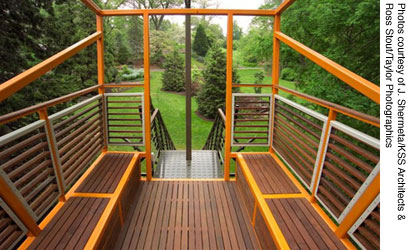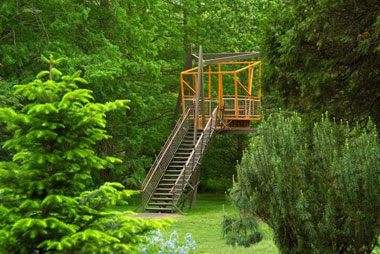| Living Fossils: Interactive Art Installation at Morris Aboretum |
|
October 24, 2006, Volume 53, No. 9
|
|
 |
| Inside view of the “Grasshopper” art installation, a visually arresting haven in the Metasequoia grove. The raised structure is equipped with wooden benches and listening devices for comfort while overlooking dawn redwood trees. |
 |
| Climb the structure’s stairs to get a treehouse view of the gardens below. |
Visitors to the Morris Arboretum’s Madeleine K. Butcher Sculpture Garden can enjoy the fall foliage by using their interactive art installation, meta Metasequoia. This sculpture elevates visitors up into the tree canopy by means of an artistic structure with stairs leading to the “basket,” an open-air room whose floor is 12 feet above grade. By climbing up into the structure, nicknamed the “Grasshopper,” visitors can revisit the childhood feeling of being in a tree house, enjoy the views and relax in unusual intimacy with the dawn redwoods.
The installation is the creation of artists John McQueen and Margo Mensing, who have collaborated previously on projects dealing with local history and ecology. It was designed by Philadelphia-based architect J. Shermeta of KSS Architects, a firm specializing in educational projects.
McQueen and Mensing’s meta Metasequoia expands Morris Arboretum’s mission as an historic public garden and educational institution promoting an understanding of the relationship between plants and people through programs that integrate science, art and the humanities.
From their very first visit to the Arboretum, Ms. Mensing and Mr. McQueen were fascinated by the Metasequoia glyptostroboides (dawn redwood) at the Arboretum, especially in the grove along the East Brook in the Sculpture Garden. Deciduous conifers, this group of trees stands as a beacon throughout the garden. The artists wanted to provide an opportunity to witness the beauty of these fast-growing living fossils, which currently stand over 100 feet tall. “The goal is to encourage participation with nature, not merely display an object sitting in the grass,” said Mr. McQueen.
Wooden benches on the perimeter of the basket provide an opportunity for quiet contemplation of one of the most sculptural forms of nature. The basket is made from tangerine painted steel and hardwood. A narrative sound piece is installed on the observation platform with history and botanical insights on Metasequoia trees, told through a fanciful dialogue between two characters, a Metasequoia tree and a bird. Music and other sounds complement the narrative. Sound projecting units are installed inconspicuously on the viewing platform so that visitors will hear sound amplified at several points on their journey up into the trees.
Displaying art in the garden is a tradition that began with the Arboretum’s founders, John and Lydia Morris and continues with the Arboretum’s Sculpture Garden, which was established in 1988 and is supported by the Madeleine K. Butcher Fine Arts Endowment. The garden is an outdoor gallery along the banks of the Wissahickon Creek, dedicated to featuring the temporary works of significant regional emerging artists and integrating sculpture and the fine art of garden design.
The Morris Arboretum is located at 100 Northwestern Avenue in the Chestnut Hill. The 92-acre horticulture display garden features a spectacular collection of mature trees in a Victorian landscape. The Arboretum features numerous picturesque spots such as the formal Rose Garden, Japanese Gardens, Swan Pond, meadows, and the elegant Fernery. For more information see the Morris Arboretum’s website, www.morrisarboretum.org. |